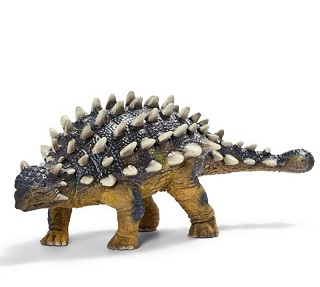
Saichania is a remarkable dinosaur from the Late Cretaceous period, specifically the Campanian to Maastrichtian stages, around 83 to 66 million years ago. It belongs to a group of herbivorous dinosaurs known as ankylosaurids, characterized by their heavily armored bodies and defensive adaptations.
Saichania is classified as an ankylosaurid dinosaur, a subgroup of armored dinosaurs that were characterized by their thick, bony plates and tail clubs. The first fossils of Saichania were discovered in Mongolia, specifically in the Nemegt Formation, which is well-known for its rich dinosaur fossils. These fossils were first described in the 1970s, providing crucial insights into the anatomy and lifestyle of ankylosaurid dinosaurs.
| Name: | Saichania dinosaurs |
| Size: | Around 13-16 feet in length. |
| Main Facts: | Saichania's distinctive tail club and extensive body armor made it a formidable defensive herbivore during the Late Cretaceous period. |
Saichania lived during the Late Cretaceous period when much of present-day Mongolia was a diverse and lush ecosystem. Fossils of Saichania suggest that it was a terrestrial dinosaur, adapted to the habitats of the time.
As a herbivore, Saichania would have spent much of its time grazing on low-lying vegetation. Its armor and tail club would have served as its primary defense mechanisms against predators such as theropod dinosaurs. When threatened, it could have swung its tail club to deter or fend off attackers.

Saichania was a heavily armored dinosaur with several distinctive physical characteristics :
The most striking feature of Saichania was its extensive body armor, consisting of bony plates (osteoderms) embedded in its skin. These plates provided protection against predators.
Like many ankylosaurids, Saichania had a tail club at the end of its tail. This tail club was a formidable weapon for defense, capable of delivering powerful blows to potential attackers.
Saichania had a low-slung body, which, combined with its armor, made it a relatively slow-moving but well-protected herbivore.
Its teeth were adapted for grinding plant material, indicating a herbivorous diet, likely consisting of ferns, cycads, and other Cretaceous vegetation.
Saichania holds significance in the world of paleontology for several reasons :
As an ankylosaurid, Saichania represents the diverse group of armored dinosaurs that evolved various adaptations for defense against predation.
Fossils of Saichania provide valuable information about the Late Cretaceous ecosystems of Asia, including the types of plants and animals that coexisted with this heavily armored herbivore.
The presence of the tail club in Saichania and other ankylosaurids suggests complex behaviors related to defense and interactions with predators.
Saichania, a Late Cretaceous ankylosaurid dinosaur, was characterized by its heavily armored body adorned with bony plates. It featured a low-slung build and a tail club, which served as defensive weapons. Saichania's herbivorous diet was adapted for grinding vegetation.
Fossils of this dinosaur have been found in Mongolia's Nemegt Formation, providing crucial insights into the anatomy and lifestyle of ankylosaurid dinosaurs. The extensive body armor and tail club of Saichania were adaptations for protection against predators, and it likely grazed on a diet of Cretaceous ferns, cycads, and other plant material in the lush ecosystems of its time.
Comparing Saichania to other dinosaurs sheds light on the diversity of herbivorous and armored dinosaurs :
Saichania belongs to the group of ankylosaurid dinosaurs, known for their heavily armored bodies, tail clubs, and herbivorous diets. This classification places it among dinosaurs like Ankylosaurus and Euoplocephalus.
Saichania, like other ankylosaurids, was a herbivore, feeding on vegetation such as ferns, cycads, and other Cretaceous plants.
Saichania shared the defining feature of ankylosaurids—extensive body armor. These bony plates offered protection against predators, and tail clubs served as defense mechanisms.
Saichania was relatively smaller than some other ankylosaurids like Ankylosaurus, which could reach lengths of up to 20-30 feet. The size variation within ankylosaurids reflects their diverse evolutionary history.
While Saichania had a tail club, the design and size of tail clubs varied among ankylosaurids. Some had larger and more elaborate tail clubs, potentially used for different purposes.
Saichania fossils have been found in Mongolia, whereas other ankylosaurids had a broader geographic range, including North America. Geographic differences influenced their ecosystems and interactions with other species.
Saichania existed during the Late Cretaceous, and its presence in Mongolia provides insights into the fauna of that region during this time. Comparatively, other ankylosaurids existed in different periods within the Mesozoic Era.
While all ankylosaurids were herbivores with defensive adaptations, their specific ecological roles, such as dietary preferences and interactions with contemporaneous predators, may have varied.